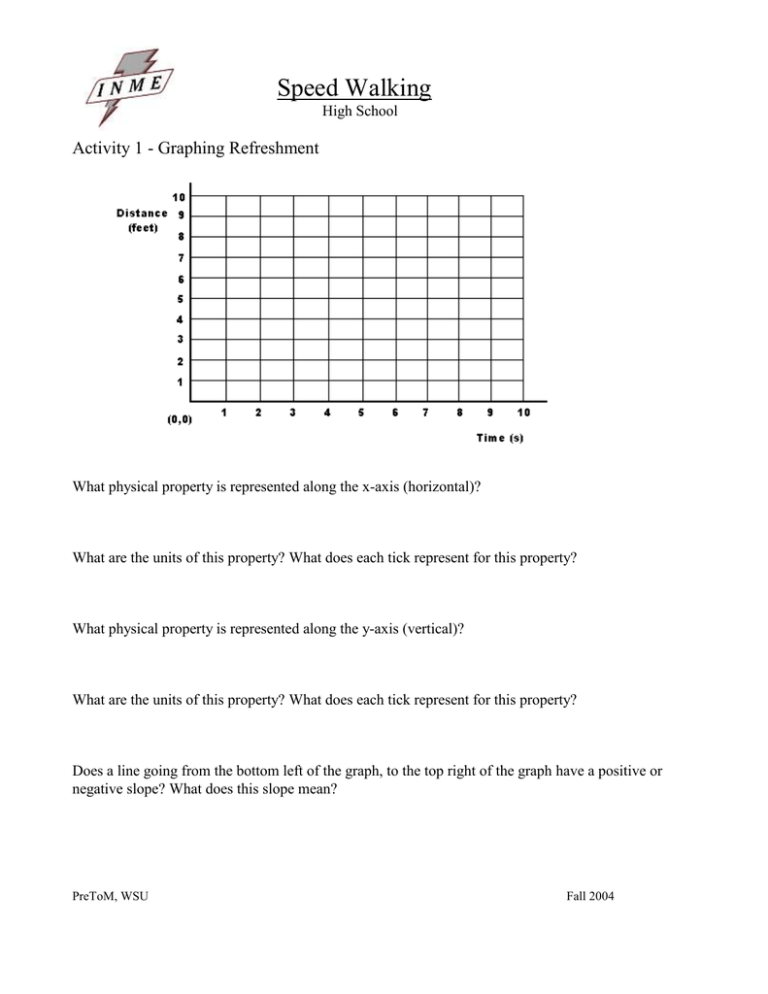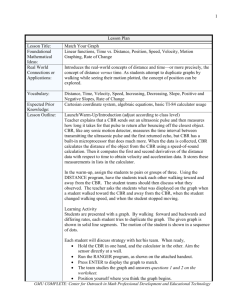Speed Walking Activity 1 - Graphing Refreshment
advertisement

Speed Walking High School Activity 1 - Graphing Refreshment What physical property is represented along the x-axis (horizontal)? What are the units of this property? What does each tick represent for this property? What physical property is represented along the y-axis (vertical)? What are the units of this property? What does each tick represent for this property? Does a line going from the bottom left of the graph, to the top right of the graph have a positive or negative slope? What does this slope mean? PreToM, WSU Fall 2004 Does a line going from the top left of the graph, to the bottom right of the graph have a positive or negative slope? What does this slope mean? Activity 2 - Getting To Know Your CBR In this Activity you will experiment with your CBR motion detector. Try standing still, walking away from it, walking towards it, or anything that you can think of. Make sure to copy each of the graphs from the calculator onto your graph paper given below, this way you will be able to refer back to them later on. Also label the walk that generated each type of graph. PreToM, WSU Fall 2004 PreToM, WSU Fall 2004 Activity 3 - The Prediction Challenge For this activity you will be given a set of movement instructions, you will first predict how the graph of this movement will look. Then you will actually act out this movement to see if your prediction was correct. A. 1) Stand a foot and a half in front of the CBR and stand still for ten seconds. 2) Stand 5 feet away from the CBR and stand still for ten seconds. Sketch each graph in a different color and label each graph. Predictions Actual Movements PreToM, WSU Fall 2004 What is the similarity between these graphs representing the two different walks? What is the difference? What does the y-intercept represent? B. 1) Start a foot and a half from the CBR and walk away from it at a speed of 1 foot per second. 2) Start 5 feet away from the CBR and walk away from it at a speed of 1 foot per second. Sketch each graph in a different color. Label each graph. Predictions Actual Movements PreToM, WSU Fall 2004 How are these graphs different from the ones you just did in part A? What does this difference represent? Is the slope of this graph positive or negative? What does this mean? C. Start 10 feet away from the CBR, walk towards it at a speed of 2 feet per second. Predictions Actual Movements PreToM, WSU Fall 2004 How was this graph different from the previous graphs? Why was this one different? Was the slope of this graph positive or negative? What does this slope represent? D. Start a foot and a half away from the CBR. Walk away at a speed of 1 foot per second, for 3 seconds. Stop and stand still for 4 seconds, then walk away at a speed of 1 foot per second for 3 seconds. Predictions Actual Movements PreToM, WSU Fall 2004 What happens to the graph when you stop moving? Why is this so? Are the slopes in this graph positive, negative, or zero? E. Start a foot and a half in front of the CBR and walk away from it, at a speed of 2 feet per second for 3 seconds, stop and stand still for 3 seconds, and then walk back towards the CBR at a speed of 2 feet per second for 3 seconds. Predictions Actual Movements PreToM, WSU Fall 2004 How is this graph different from the last one you did in part D? What does this change represent? This graph is made up of different pieces that meet. What is the slope for each linear piece in this graph (that is are the slopes positive, negative, or zero)? Follow Up Questions - Summarize what you have learned by answering the following questions for any graph that is linear or made up of connecting linear pieces (piece wise linear) What does the slope of a linear graph represent? Is it possible to have negative velocity? What does negative velocity look like on a Distance vs. Time graph? Which, if any, of our graphs have negative velocity? How would you calculate velocity by looking at a Distance vs. Time graph? PreToM, WSU Fall 2004 Activity 4 - The Final Walk-off In this activity you will be given a sample graph. Each group will write directions of how the walker should move (where the walker begins, whether they walk away from the CBR, walk towards the CBR, stand still, and the speed of the walk) in order to duplicate their given graph. When the instructions are complete, the group will choose a coach and a walker. The coach will instruct the walker what to do as the try to recreate their graph in front of the class. Movement Instructions - PreToM, WSU Fall 2004

